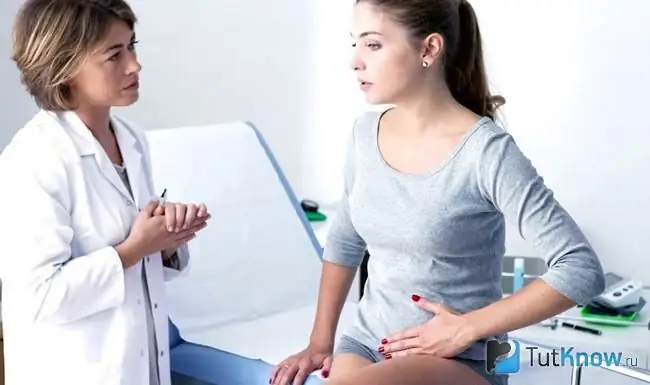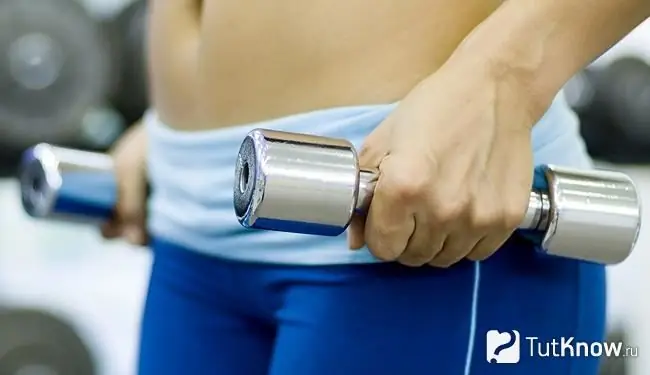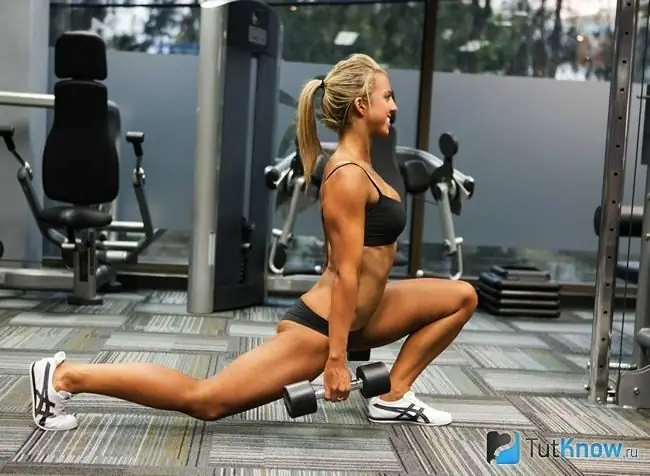- Author Arianna Cook [email protected].
- Public 2024-01-12 17:55.
- Last modified 2025-01-23 09:40.
Find out what loads are contraindicated for ovarian cysts, is it possible to exercise at all and what exercises to do to treat the disease. Most often, cystic neoplasms on the ovaries are diagnosed in women of reproductive age. For this reason, many are interested in what contraindications exist for this ailment, and also whether ovarian cyst and sports can be combined. This is understandable. Indeed, today many women are actively involved in fitness, trying to strengthen their health and improve their figure. Despite this diagnosis, they do not want to stop leading an active lifestyle.
Contraindications for ovarian cysts

As we have already said, this ailment presupposes the presence of some contraindications. Of course, first of all, you need to consult with a specialist, since some types of neoplasms may not affect the overall health of a woman in any way. However, if there are risks of complications, it is worth considering carefully whether it is worth the risk. With this ailment, you should not do the following:
- Visit SPA and take physiotherapy services without first consulting a specialist. We do not recommend carrying out procedures for wrapping, lymphatic drainage, etc.
- Take hot baths or visit the sauna (bath).
- Spend a long time in the sun or in a solarium.
- Self-medicate.
- Do not actively train the abdominal muscles.
Now we have talked only about the most common contraindications, but their list, depending on the severity of the disease, can be expanded. It is not for nothing that we mentioned a preliminary consultation with a specialist, because in some situations even a light massage can cause serious harm, and sometimes active sports are completely safe.
What is an ovarian cyst and how does sports affect it?

An ovarian cyst is a benign neoplasm of elongated or round shape, the size of which can reach nine centimeters in diameter. The neoplasm can be localized inside the organ or outside. The most common cause of ovarian cysts is malfunctioning of the hormonal system. Let's note the main factors that can cause the appearance of a neoplasm:
- Frequent and prolonged stress.
- Excessive physical activity.
- Various injuries of the abdomen and organs of the reproductive system, including abortion.
- Chronic diseases of an infectious or inflammatory nature that develop in the organs of the reproductive system.
- Genetic predisposition.
- Malfunctions of the hormonal system.
An ailment can arise and develop without symptoms, which makes it difficult to diagnose it. After several months, the cyst may disappear on its own or regress. Women who have been diagnosed with this need to restrict themselves somewhat.
The most effective treatment for ovarian cysts is a combination of drug therapy and a healthy lifestyle. When answering the question of whether an ovarian cyst is compatible with sports, it is necessary to take into account the degree of complexity of the disease. At the same time, it is worth remembering the benefits of playing sports for the whole body. Moderate physical activity has a positive effect on the work of the cardiovascular system, improves blood flow, increases the rate of metabolic processes, etc.
However, with an ovarian cyst, the sport should be chosen on an individual basis, taking into account all the restrictions. If the cause of the development of the disease was an inflammatory disease, then it is better not to engage in sports at all. You can start training only after complete recovery, and at the same time, the load must be increased gradually.
It is necessary to carefully approach the choice of exercises, since some of them can provoke a rupture of the neoplasm. For any type of cyst, you should not do high-intensity exercise on your abdominal muscles. Abs workouts for cysts are possible, but only light. If polycystic disease has been diagnosed, then physical activity is necessary and exercise is one of the elements of therapy. This is due to the fact that exercise promotes fat burning, and polycystic disease is extremely difficult to treat if you are overweight. Thus, it is impossible to do without physical activity and an appropriate dietary nutrition program. With a cyst, the following types of physical activity are possible:
- Physiotherapy - is often prescribed by a doctor as an integral part of therapy. Depending on the severity of the disease, the complex may contain only light exercises, or training on simulators is allowed.
- Easy jogging - if running is intense, then pain in the lower abdomen may appear. We recommend that you consult with a specialist in advance and start jogging only after his consent.
- Walking - if running is contraindicated for you, then walking will certainly be allowed. This is a safe type of physical activity that can activate lipolysis processes, strengthen the spinal column and improve mood.
Some physical activities can work well, and your doctor can help you do just that.
What exercises are prohibited for ovarian cysts?

If the neoplasm is small and does not manifest itself in any way, then there are no restrictions on exercises. However, it is important not to overwork yourself. If the size of the cyst is large, then it is definitely worth giving up the following exercises:
- Sharp inclinations of the body.
- Jumping.
- Flapping movements of the lower limbs.
- Sharp attacks.
- Squats.
- Exercises for the muscles of the press.
- Lifting weights.
- Intense running.
Exercise at high intensity can make the situation worse. With a follicular cyst, apoplexy (rapid tissue rupture) is often observed. This phenomenon can be triggered by the rapid growth of the cyst or sudden movements. Note that apoplexy is possible with any size of the neoplasm.
Special exercises to treat ovarian cysts

One of the most frequent factors in the appearance of neoplasms in the female genital organs is blood stasis. It is because of poor blood circulation that these pathologies are possible. As you probably know, blood stagnation occurs with a passive lifestyle. Related to this is the fact that moderate physical activity is often included in therapy.
By performing special movements, you can quickly get rid of this ailment. The easiest and simplest exercise is to draw in and puff up the abdomen. Under the influence of the load, all internal organs located in the abdominal cavity are compressed, which leads to a rapid outflow of blood. As a result, this simple exercise will allow you to get rid of blood stagnation and speed up your recovery.
The best results can be obtained by combining the above exercise with breathing exercises. Draw in your stomach while exhaling, and inflate it as you inhale. Perhaps not everyone will be able to do this right away, but after a little practice, problems will not arise. For five minutes, we recommend doing at least 25 reps. Repeat the exercise eight times during the day. Note that you can take any position that suits you. By the way, some experts believe that this movement can speed up the processes of lipolysis in the abdomen. However, you should not count on serious results in terms of weight loss, because fat is burned evenly throughout the body.
Some yoga exercises can be quite effective. They are aimed at improving the condition of the female reproductive system. Various asanas are designed to return positive energy to the body. Also, you should monitor the work of the hematopoietic system, because monthly blood is lost in large quantities. According to yoga teachings, many problems with the female reproductive system are associated with blood.
We have already said that one of the most common factors in the development of a cyst is blood stasis. Yoga for women has some nuances in comparison with the exercises that are practiced by men. It is quite obvious that women's yoga has transition periods associated with pregnancy, menstruation and menopause. At different stages, certain asanas should be performed, which can be most effective only in certain situations.
If you decide to start doing yoga, then it is advisable to find an experienced mentor, but this is quite difficult to do even in large cities. This teaching was not focused solely on improving appearance. Yoga practitioners primarily strive for spiritual perfection. Improving body condition for them is a secondary effect. Often, we are taught just a set of movements, in fact, which has nothing to do with yoga.
You must remember that each asana can be repeated only once during the day. Start with a short exercise (5 to 10 seconds). Gradually, the time must be brought to five or even eight minutes. It is also necessary to make a smooth transition between all exercises. The best time to practice yoga is between 6 and 8 pm.
Ovarian cyst - is it possible to play sports after surgical removal

Removing the growth with surgery is called laparoscopy. Compared to the classical resection method, laparoscopy has several advantages. To begin with, using the new cyst removal method does not involve making an incision in the abdomen. The doctor makes only a puncture, through which a special device, a laparoscope, is inserted into the abdominal cavity.
It is equipped with a lighting device, a camera, and an instrument necessary for removing the neoplasm. During the operation, blood loss is minimized, and the puncture heals in a short time. In this case, no rough seams remain. However, despite the fact that laparoscopy is an easy method of surgical intervention and the body recovers quickly enough, it is worthwhile to postpone sports.
Within a few hours after the completion of the operation, a woman can get out of bed and move slowly. After seven days, the stitches are removed, but light physical activity is allowed only after two weeks. First of all, it is necessary to avoid a strong load on the abdominal muscles, and even sexual intercourse is prohibited for some time. After laparoscopy, walking is the best choice. As the body recovers, the load can be gradually increased. You should consult with your doctor, who will tell you exactly what loads are allowed and when.
For more information on gymnastics with an ovarian cyst, see the video below:






